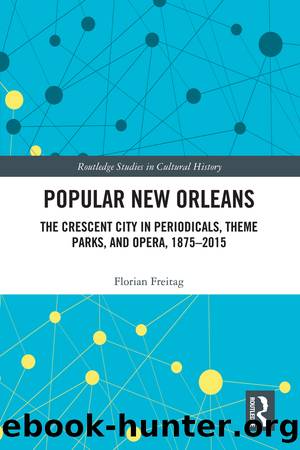Popular New Orleans by Florian Freitag

Author:Florian Freitag [Freitag, Florian]
Language: eng
Format: epub
Tags: History, United States, 19th Century, 20th Century, 21st Century, Modern, General, Social History
ISBN: 9781000196955
Google: NVLzDwAAQBAJ
Publisher: Routledge
Published: 2020-10-01T16:00:50+00:00
Autotheming: From Disneyâs New Orleans to Disneyâs Disneyâs New Orleans
Disneyâs return to external and internal brands in New Orleans Squareâs lessee outlets and âattraction stores,â respectively, can not only be seen as the result of a switch in managerial strategies at the parkâs Merchandise department, however. Especially the addition of âattraction storesâ also illustrates the growing thematic self-referentiality of theme parks in general and New Orleans Square in particular. Elsewhere, I have argued that for at least two decades, âtheme parks have increasingly relied on theme parks and their historic antecedents (trolley parks, amusement piers, and county fairs) as themes for rides, shops, restaurants, and entire themed areasâ (Freitag, âAutothemingâ 141; see also Clavé 79). Such cases of âautotheming,â as I have called them, can be regarded as subsets of what Beardsworth and Bryman have termed âreflexiveâ theming, a trend in which âthe thematic elements are internally generated and then continuously reproducedâ (Bryman, Disneyization 18).58 While reflexively themed and/or autothemed spaces can be found in many theme parks all over the world (see Freitag, âAutothemingâ for examples from North American, European, and Asian parks), they seem to be especially popular in parks owned by multimedia entertainment corporations such as Disney and NBCUniversal, where they are often used to cross-promote the companiesâ various media franchises (e.g., movies, TV shows, or, indeed, theme park rides).
Yet reflexive theming and autotheming are more than just effective marketing tools. Drawing on âinternally generatedâ brands, franchises, and images, as well as â in the most extreme cases â exclusively on themselves rather than on external thematic sources, reflexively themed and especially autothemed spaces raise todayâs theme parks to a level of hyperreality or simulation that the original proponents of these concepts, Umberto Eco and Jean Baudrillard, had imagined either only in theory or in jest. Baudrillard, for instance, had originally considered Disneyland a âsimulation of the third orderâ (âit masks the absence of a profound realityâ; Simulacra 12; and 6; emphases original). Roughly ten years later, he saw the opening of the movie-themed Disney-MGM Studios theme park at Walt Disney World as â[o]ne more spiral in the simulacrumâ and jokingly added: âOne day they will rebuild Disneyland at Disneyworldâ (Cool Memories II 42). One can only wonder what Baudrillard would say now that his prediction has, in a way, come true: to be sure, there is no Disneyland at Walt Disney World (or vice versa), but both parks feature rides, shops, restaurants, shows, and parades whose theming refers to nothing but the parks themselves, either directly or via Disneyâs representations of the parks in other media. These spaces are indeed âpure simulacra,â having âno relation to any reality whatsoeverâ (Baudrillard, Simulacra 6). And many of them can be found in New Orleans Square.
Indeed, there are numerous examples for how, like the city of New Orleans, New Orleans Square has become ânostalgic for itselfâ (Dawdy 110). Among the earliest are the âattraction storesâ âPieces of Eight,â âLe Bat en Rouge,â and âPort Royal,â opened in 1980, 2001, and 2006, respectively.
Download
This site does not store any files on its server. We only index and link to content provided by other sites. Please contact the content providers to delete copyright contents if any and email us, we'll remove relevant links or contents immediately.
| Direction & Production | Genres |
| Guides & Reviews | History & Criticism |
| Reference | Screenwriting |
| Shows |
Head of Drama by Sydney Newman(2030)
Robin by Dave Itzkoff(2026)
I'm Judging You by Luvvie Ajayi(1897)
The Paranormal 13 (13 free books featuring witches, vampires, werewolves, mermaids, psychics, Loki, time travel and more!) by unknow(1852)
Single State of Mind by Andi Dorfman(1519)
Ten by Gretchen McNeil(1513)
#MurderTrending by Gretchen McNeil(1405)
Key to the Sacred Pattern: The Untold Story of Rennes-le-Chateau by Henry Lincoln(1356)
Most Talkative by Andy Cohen(1315)
Merv by Merv Griffin(1276)
This Is Just My Face by Gabourey Sidibe(1189)
Notes from the Upside Down by Guy Adams(1185)
Jamie Oliver by Stafford Hildred(1153)
The Hunger Games: Official Illustrated Movie Companion by Egan Kate(1125)
Springfield Confidential by Mike Reiss(1113)
Clarkson--Look Who's Back by Gwen Russell(1083)
The TV Writer's Workbook: A Creative Approach To Television Scripts by Ellen Sandler(1077)
Blue Planet II by James Honeyborne & Mark Brownlow(1027)
Dark Angel by D. A. Stern(1018)
